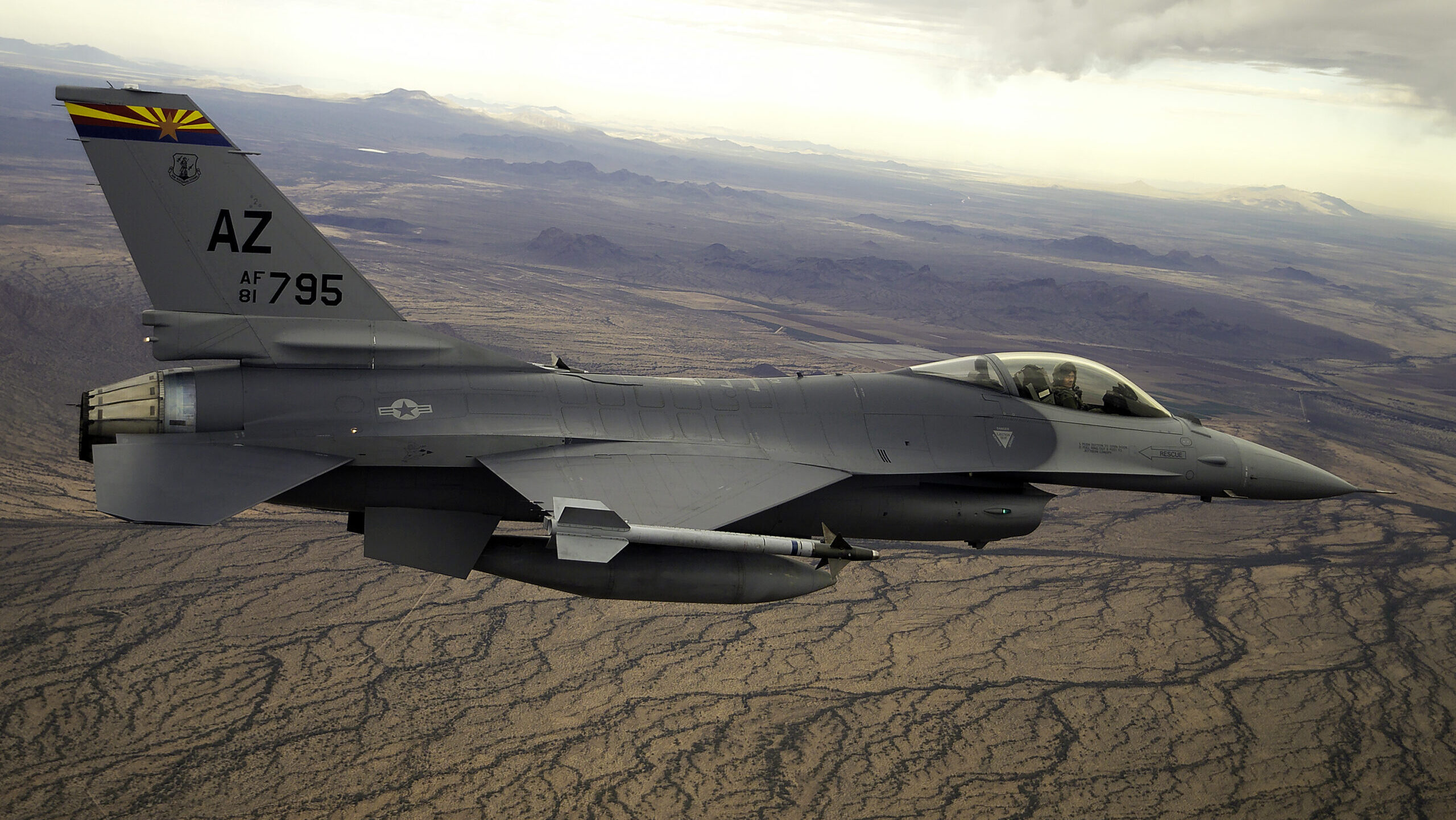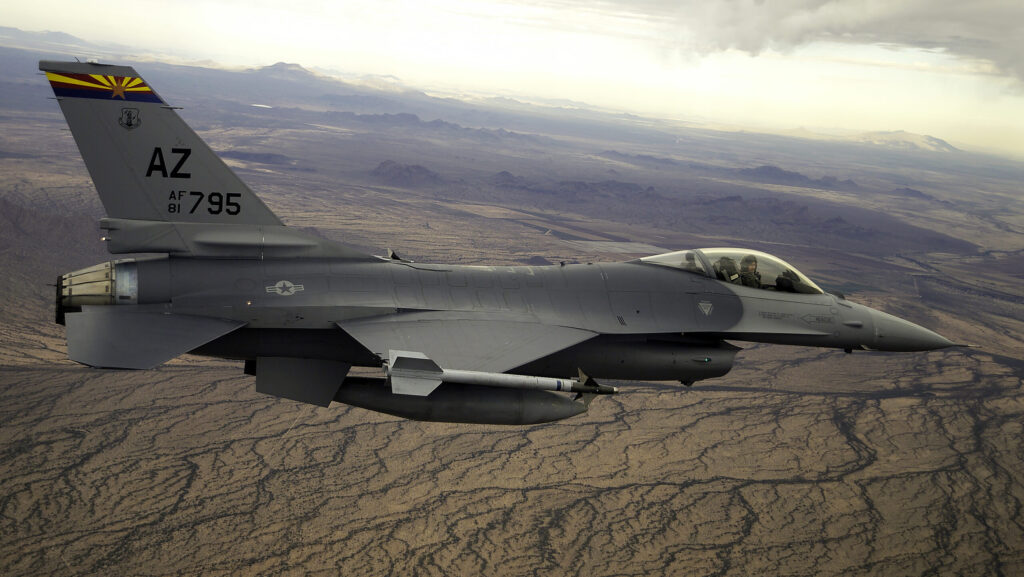New plug-and-play AI can protect pilots of non-stealth planes: Raytheon
作者:Sydney J. Freedberg Jr.

Raytheon’s AI-enhanced Radar Warning Receiver was flight-tested on an Air National Guard F-16 fighter, similar to this Arizona Air Guard jet. (Air Force file photo)
WASHINGTON — One of the largest defense companies on the planet just unveiled a small upgrade that could make a big difference in the survival rates of US aircrews. And by deploying an AI device powerful enough to be militarily useful, yet small enough to be retrofitted on a fighter jet, Raytheon’s new Cognitive Algorithm Deployment System (CADS) is a major step towards a long-sought holy grail of “cognitive electronic warfare.”
The problem CADS helps to solve is a growing one: Adversaries like Russia increasingly employ — and export — reprogrammable digital radars that can rapidly reconfigure the signals they use to locate, track and shoot down airplanes. Those rapid changes, in turn, can confound Western radar-warning systems, which work by comparing each signal they pick up to a pre-loaded database of known threats. Raytheon is fighting back by upgrading its warning systems with AI, allowing them to analyze and identify the danger in real time — and, with a little luck, alert the pilot before it’s too late to evade.
By exploiting ever-more miniaturized hardware and streamlined software, Raytheon’s CADS can run radar-analyzing algorithms on an electronics module compact enough to slot into the company’s existing ALR-69A Radar Warning Receiver (RWR). Over 600 of those RWRs are already widely used on older, legacy aircraft in both US and foreign service, ranging from the C-130 turboprop transport to the massive KC-46 tanker to the F-16 jet fighter. Such fourth-generation planes lack the stealth, sensors, and computing power of the fifth-generation F-35. (The full electronic-warfare capabilities of the F-35 are highly classified and subject to much speculation). So adding CADS could be an easy defensive upgrade to an increasingly vulnerable fourth-gen fleet.
“It’s a digital RWR that’s very flexible,” said Michael Baladjanian, Raytheon’s vice president of electronic warfare systems. “It can go on any kind of F-16,” he said, for example, or any number of other aircraft.
Specifically, the ALR-69A consists of four sensors installed around the aircraft being protected — the exact configuration depends on the type of plane — and a central processor housed in the fuselage. That processor is built with space for future upgrades, so Baladjanian’s team designed the CADS module to slot right in, without any modifications required to the ALR-69A itself.
“I didn’t have to redesign the actual 69A,” he said. “I just had to put the card in.”
It’s also easy to upgrade the CADS module itself, Baladjanian continued: “The really cool part about it, is it’s able to hold third-party apps.” That’s because CADS is built using an “open architecture” meant to accommodate new software packages from different vendors, not just Raytheon, as long as they comply with certain technical standards. (The details of those standards, unlike on most “open source” projects, are classified).
Raytheon and the Air National Guard have already flight-tested an ALR-69A upgraded with CADS running three different radar-analyzing algorithms, he said. One was developed by Raytheon, albeit a different division from Baladjanian’s; one came from Georgia Tech, a frequent partner of the Pentagon; and a third came from a small firm called Vadum (a spinoff from the University of North Carolina).
“We were able to very easily take all three algorithms and … integrate them in our lab, in less than a day,” Baladjanian said. Then Raytheon flew the CADS ALR-69A on its own test aircraft, followed by a flight on an Air Guard F-16. “Flight testing will continue through this year,” he added.
The company and the Air Force are still negotiating any purchase of CADS, so it’s too early to know numbers, pricing, or schedule, especially with the Pentagon budget facing uncertainty. But Baladjanian already has his eye on further advances.
Adding more and better algorithms to the CADS digital toolkit is the obvious first step, he told Breaking Defense. But in the not-too-distant future, he envisions expanding the AI’s capabilities from passively identifying radar signals to actively countering them. He’s “looking at electronic attack,” he said.
Such AI-controlled jamming is something technologists and tacticians have sought for years. Known in the trade as cognitive electronic warfare, it’s seen as a way to untether EW from slow-moving, ground-based analysis. In the traditional process, intelligence centers issue a Mission Data File of known threats, which aircraft must load before taking off. Then, if they encounter an unfamiliar signal, they can only collect the data, not act on it; and on landing, they must send it off to the intel hub to analyze and come up with countermeasures — a process that takes hours, days, or even months. By contrast, an aircraft with onboard AI could analyze the unfamiliar signal in near-real-time and generate custom countermeasures in mid-flight.
What Raytheon’s rolling out is not that complete capability, not yet. But it’s a big step towards it.
关于《New plug-and-play AI can protect pilots of non-stealth planes: Raytheon》的评论
暂无评论
